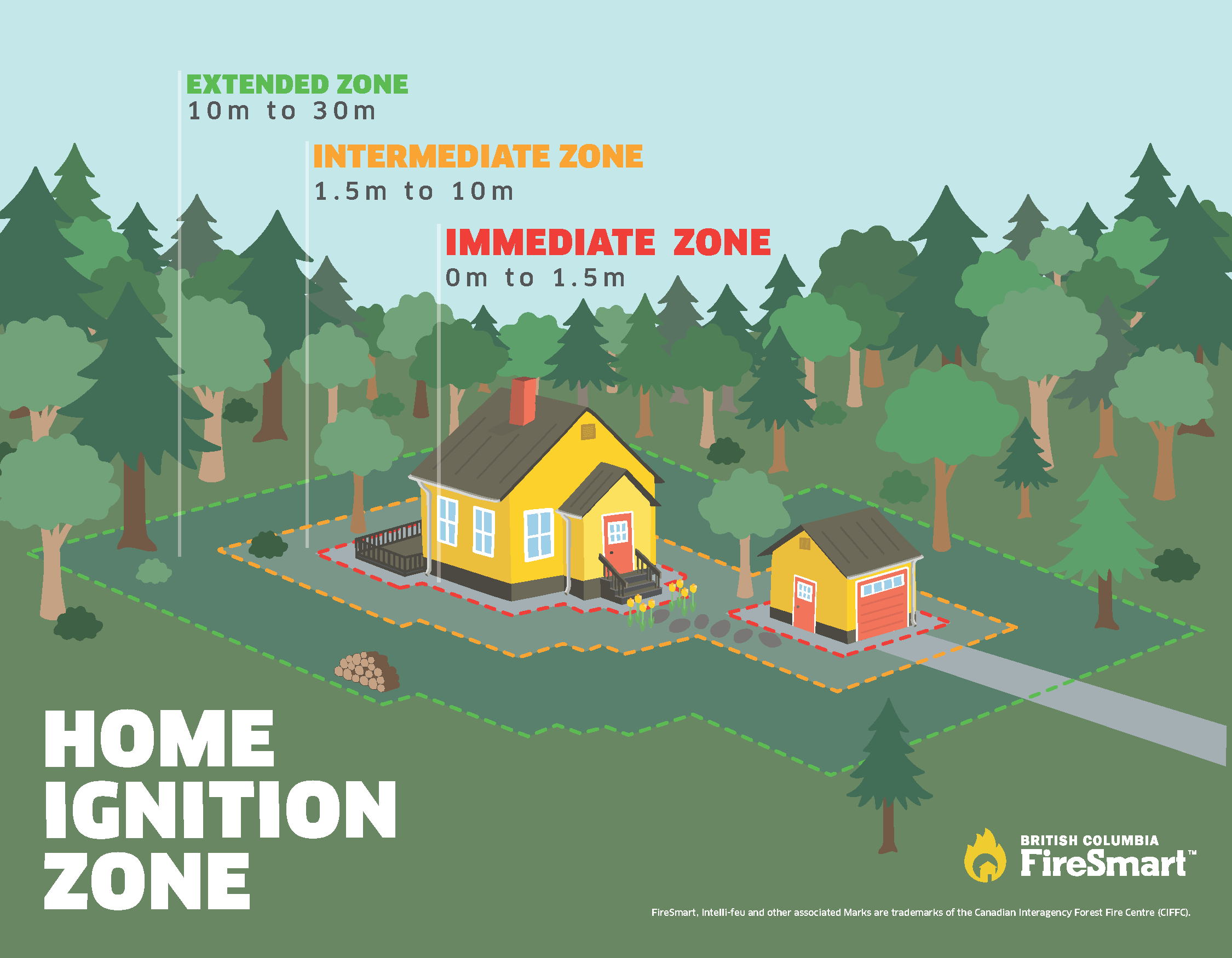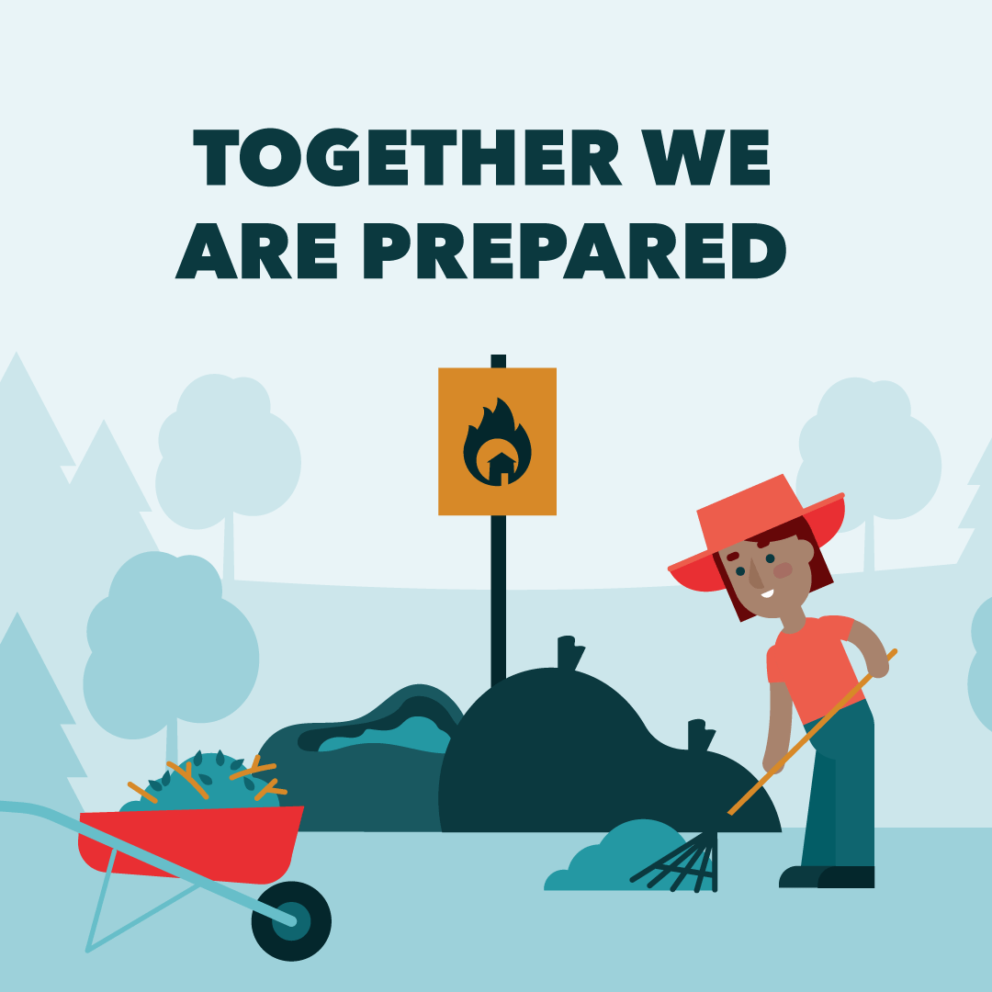FireSmart is a shared responsibility. It is about living in a fire-prone ecosystem and taking the necessary steps to protect your family, property and community from wildfire. Over time, FireSmart principles have shown that they are effective at reducing the risk related to losses in the most extreme wildfire conditions. With a few simple steps, you can contribute to increasing your property, neighbourhood and community resiliency to wildfire. Use the accordion headings below to learn about how you and your community can become FireSmart!
Community Wildfire Resiliency Plans
The Regional District of Nanaimo (RDN) has developed a range of Community Wildfire Resiliency Plans (CWRP) to provide a framework for wildfire risk mitigation. CWRP outline dozens of recommendations with suggested priority levels that, along with regional fire departments and other stakeholder input, focus on reducing wildfire risk. Access RDN CWRP for your area.
FireSmart tips
Is My Home at Risk? - Wildland Urban Interface
A Wildland Urban Interface (WUI) is the zone where human-made structures and other developments meet and intermingle with undeveloped wildland or vegetative fuels. In wildfire resiliency, we talk a lot about the WUI, because homes and structures in this zone are at the greatest risk of being affected by a wildfire. There are two different types of WUI zones, which are defined based on the amount of vegetation in them and housing density: Interface and Intermix.
![]()
Source: FireSmart BC
Where should I start? - Home Ignition Zone
The area around your home can be broken into three different zones. The Immediate Zone is your biggest opportunity to mitigate threats for fire spread and tackling simple tasks like cleaning your gutters, clearing debris from below your patio, and sweeping debris away from your porch can make the difference.

Immediate Zone (0 –1.5 meters)
The Immediate Zone is a non-combustible area that starts at the house and extends to a 1.5m perimeter around the home and attached structures, including decks. Reduce the chance of wind-blown embers igniting your home by starting with these proactive steps:
- Choose non-combustible building materials when constructing or renovating your home
- Clear vegetation and combustible material down to mineral soil and cover with non-combustible materials like gravel, brick, or concrete
- Avoid planting woody shrubs or trees. If any are present, prune and maintain them regularly
Intermediate Zone (1.5 – 10 meters)
Elements in the Intermediate Zone are managed so they don’t transmit fire to your home. Here are a few actions you can take to reduce your home’s vulnerability:
- Plant fire-resistant vegetation and select non-combustible landscaping materials
- Avoid using woody debris, including mulch
- Keep combustible items like firewood piles, construction materials, patio furniture, tools, and decorative pieces out of this zone
- Move trailers, recreational vehicles, storage sheds, and other combustible structures into the Extended Zone
- If that’s not possible, store firewood inside your mitigated garage, shed, or other ember resistant structures
- Create a non-combustible ground cover, like a gravel pad, underneath and 1.5 metres around trailers, recreational vehicles, and sheds.
Extended Zone (10 – 30 meters)
The goal in the Extended Zone is not to eliminate fire, but to reduce its intensity. If your property extends into this zone, a few important steps you can take include:
- Selectively removing evergreen trees to create at least 3 metres of horizontal space between single or grouped tree crowns
- Removing all branches to a height of 2 metres from the ground
- Regularly cleaning up accumulations of fallen branches, dry grass, and needles to eliminate potential surface fuels
- Continuing to apply these principles if your property extends beyond 30 metres
- Working with your neighbours in overlapping zones and seeking guidance from a forest professional if affected by other conditions like steep slopes.
Source: FireSmart BC
What can I do at my Home? - FireSmart Begins at Home manual
There are many simple steps you can take around your home and property to become more FireSmart. A great place to start is creating a regular yard maintenance routine. This includes cleaning out your gutters, keeping the grass less than 10cm high, and clearing vegetation away from your home and combustible fence. Check out the FireSmart Homeowner’s Manual for tips to create a non-combustible zone around your home to reduce the risk from wildfire damage.
Source: FireSmart BC
How can I keep my Neighbourhood safe? - FireSmart Canada Neighbourhood Recognition Program
FireSmart Canada developed the FCNRP to officially recognize neighbourhoods that have taken critical steps in reducing their vulnerabilities to wildfire. Because FireSmart is most effective when neighbours band together, this program is a great way to encourage your community to become FireSmart and to celebrate the steps you've taken collectively.
Connect with a FireSmart Representative
The RDN has certified Local FireSmart Representatives to help you on your journey. Locate your local FireSmart Representative by emailing us ay firesmart [at] rdn.bc.ca (FireSmart[at]rdn[dot]bc[dot]ca). We will connect you with a representative who will lead you through the FireSmart Home Assessment process, connect you with valuable resources, and help you organize a FireSmart Committee.
FireSmart recongition status for your community
If your neighbourhood, subdivision or small town is prone to wildfire, you can get FireSmart recognition status by meeting the following criteria:
- Enlisting a wildland/urban interface specialist to complete an assessment and create a plan that identifies locally agreed-upon solutions that the neighbourhood can implement
- Sponsoring a local FireSmart committee, which maintains the FireSmart Neighbourhood Plan and tracks its progress or status
- Conducting FireSmart events each year that are dedicated to a local FireSmart project
- Investing a minimum of $2 per capita annually in local FireSmart Neighbourhood efforts
- Submitting an annual report to FireSmart Canada that documents continuing compliance with the program
- For more information, email us at Firesmart [at] rdn.bc.ca (FireSmart[at]rdn[dot]bc[dot]ca).
Learn more about FireSmart BC Neighbourhood Recognition Programs. 
What should I do if I'm building a new home? - Homebuilding and development considerations
- Follow FireSmart principles when developing land, designing homes and structures, and landscaping on properties within the RDN - it's an important part of the planning and development process
- Ask your developers, builders, contractors and homeowners to review the FireSmart basics and follow FireSmart building practices when designing, planning and building in the RDN to mitigate wildfire risk.
Learn more
- Creating a FireSmart Home and Property (RDN)
- FireSmart building material fact sheets
Source: FireSmart BC
What should I plant in my yard? - Landscaping and gardening
FireSmart Landscaping
Fire resistant plants do not readily ignite from flame or other ignition sources. These plants can still be damaged or even killed by fire but their foliage and stems do not significantly contribute to the fuel and fire intensity.
Characteristics of fire-resistant plants:
- Low amount of sap or resin material moist
- Supple leaves
- Accumulate minimal dead vegetation
- Water-like sap with little odour
Characteristics of highly flammable plants:
- Leaves or needles are aromatic
- Accumulate fine, dry dead material
- Contain resin or oils loose
- Papery or flaky bark
Examples of plants to avoid planting
- Cedar
- Juniper
- Pine
- Tall grass
- Spruce
FireSmart planning
Plan your landscape with low water requirements that are also FireSmart. Water conservation and environmental protection are values shared by all of us. Learn more:
- FireSmart and WaterSmart Landscaping Guide (RDN)
- FireSmart BC Landscaping Guide (FireSmart BC)
- FireSmart Guide to Gardening (City of Campbell River & Strathcona Regional District)
- WaterSmart Landscaping Guides (RDN)
Source: FireSmart BC
For the kids
Meet Ember
Meet Ember, FireSmart's official new mascot. She makes for the perfect FireSmart messenger because of her unique characteristics, which include alertness, adaptability, intelligence and community mindedness. See Ember in action and download the following.
- Ember Comic
- Ember Crossword Puzzle
- Ember’s Colouring Book (English & French)
- FireSmart Kid’s Home Assessment
- Ember’s Story Video
- Ember Word Search Games
- FireSmart BC Library Program
- FireSmart Matching Game
- Firefighter Cookbook
- Colouring Page
Are you an educator?
Looking to use Ember in your educational or marketing materials? Use the Ember usage request form to apply for a package of official Ember poses and instructions.
Source: FireSmart BC
Contact us
For more information on FireSmart in the RDN, email us at Firesmart [at] rdn.bc.ca (FireSmart[at]rdn[dot]bc[dot]ca).
